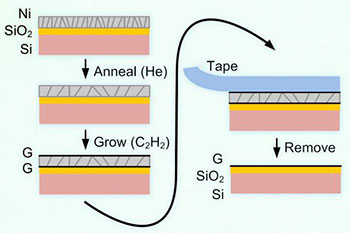Technique might enable advances in display screens, solar cells, or other devices.

llustrated here is a new process for making graphene directly on a nonmetal substrate. First, a nickel layer is applied to the material, in this case silicon dioxide (SiO2). Then carbon is deposited on the surface, where it forms layers of graphene above and beneath the SiO2. The top layer of graphene, attached to the nickel, easily peels away using tape (or, for industrial processes, a layer of adhesive material), leaving behind just the lower layer of graphene stuck to the substrate. Image courtesy of the researchers